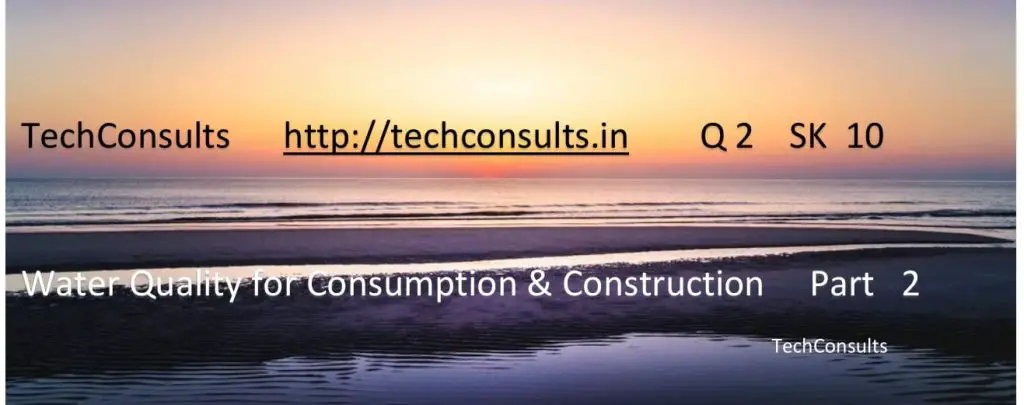


Introduction–The purpose of sharing this information, in this extension as part 2 is that with the changes in construction environment, awareness must be created in knowing the water quality and its use in construction. And at the same time people must be aware of actions that pollutes water from construction and other industry use or domestic use of water.
Causes of Pollution, Waste to Effluent management Processes, Action of water on cement and steel, after effects of polluted water, Preventive steps to check pollution, Major pollution control parameters, Actions required.
The purpose of sharing this information is that with the changes in construction environment, awareness must be created in knowing the water quality and its use in construction. And at the same time people must be aware of actions that pollutes water from construction use or domestic use of water.
Causes of pollution.
Agricultural management require pesticide and fertilizer use to get the crop output in right way and in required quantity. All is not used and remain in top soil. Fecal matter of animals and humans also remains in the top soil. These pollutants are washed away with rain water and travel through drains streams to rivers. Also, sewage is a major pollutant contributor. The problem is more serious when the streams and rivers are not in stage. That is in the dry season.
Industrial waste
The type of waste depends upon the type of industry in which different type of chemicals are released during the manufacturing / processing period and the effluents from these industries find their way ultimately to rivers or the ground water.
Infrastructure development waste
The waste produced in construction projects from rural development to urban development to development in oil gas and energy sectors, contributes to pollutants, that affects the environment (land, air, water) and have direct impact on construction workforce.
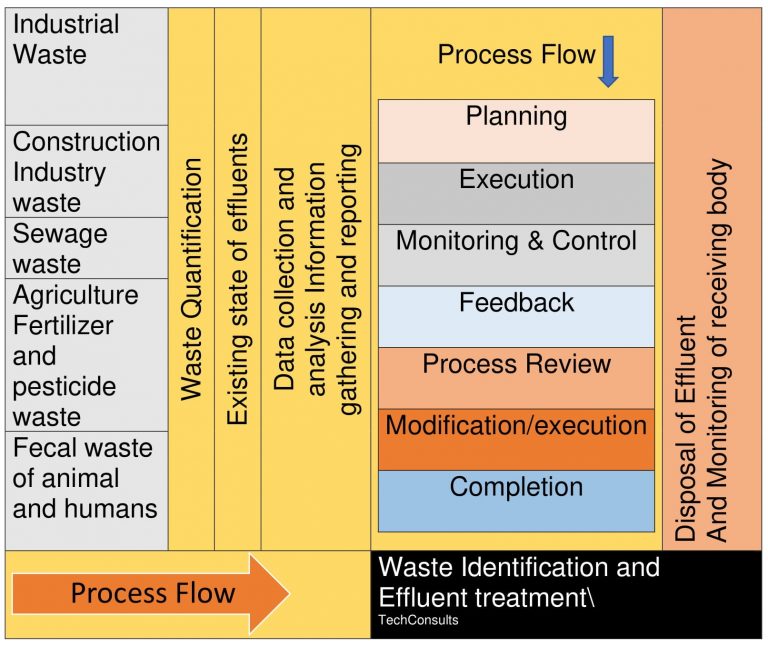
The existing water sources particularly in lean periods need to be checked for quality aspects, frequently and after getting the results, a through planning and process execution must be decided so that the domestic needs, the agriculture needs are fulfilled and water quality is safe so as not to harm the concrete and steel used in construction.
The Action of Water
The action of water on cement and all other things where cement is used, (such as concrete, RCC, plaster, floor finishes) is very important to get desired properties in product development with cement, in fresh and hardened state of such products.
The properties of cement products are:
Workability of the concrete
Initial setting time
Final setting time
Strength of concrete plaster and masonry
Curing
Durability of concrete
Cement reacts in presence of water and the gel is produced which acts as a binding material among the different constituents of concrete.
The chemical properties of water affect the gel formation and thus the ultimate product is affected in achieving its required properties.
pH (potential of Hydrogen)
It is a measure of alkalinity or acidity of water at a given temperature.
Type of Solution | pH | Suitable range for surface water is 6.6 to 8’5Suitable range for drinking water is 6.0 to 8.5 | ||
Acidic | <7 | pH<6.5-water is acidic, sour in taste, water may contain Fe, Mn, Ca, Pb, Zn and is not fit for washing clothes | Hydrogen ion is more active | |
Neutral | 7 | pH of pure distilled water | Hydrogen and OH ion are equally active. | |
Basic or Alkaline | >7 | pH > 8.5 is hard water | OH, ion is more active |
If the pH is on lower side then the salts of Fe, Mn, Ca, Pb, Zn may reduce the initial strength of concrete.
Steel in RCC may rust.
The acids, the waste and sugar, reduces strength of mortar or concrete.
The silt in water reduces strength of concrete
Oils and lubricants present in water may reduce the strength by about 20%
Algae in water used for concrete reduces its strength and its bond strength with steel
Concrete having reinforcement may spall and steel may rust
Reinforcement is used in concrete to provide it strength in bending, compression, tension, torsion and shear etcetera. Steel contains carbon and the contents of carbon vary as per required quality of steel. This steel is hot rolled and cooled to provide smooth or ribbed steel.
The water present in concrete enters the rusted pores of steel and around steel to form a layer of (OH) ions of Fe and Ca. The (OH) ion activity raises the pH of liquid around the steel and on setting forms a protective layer around steel which protects the steel from atmospheric actin. (Passivate steel)
The surrounding environment of reinforced cement concrete (RCC) consist of air (all types of gases present), water (all types of water), and land (all types of earth). Also, the pure water of rain washes away some particles of concrete and creates spaces on the surface of concrete.
The aggressive elements from the surrounding environment such as Cl and CO2 penetrate in to concrete, and as they reach near reinforcement insubstantial amount creates rusting. The rusting causes expansion and the concrete spalls.
Cl is present in air and is soluble and may enter concrete pores from water and outside water.
CO2 present in air enters the pores of concrete and acta with Ca and pore water to form calcium carbonate. Which is expansive and is a cause of concrete deterioration. CO2 needs moist conditions for its action. the atmosphere to have humidity > 70 %.
The surface needs to be protected to avoid the action of such pollutants.
After effects of polluted water:
If consumed for drinking water needs may, human and non-humans can suffer from water borne diseases such as Typhoid, Cholera, Diarrhea, TB, Jaundice, etcetera.
Organic matter present in water during its bio degradation process consumes oxygen, which reduces BOD of water. Low oxygen availability is harmful for aquatic life.
The organic matter from sewage and industrial effluents, provide nutrients to water bodies and drains. This increases plant life, decreases oxygen, and as such affects aquatic life.
TDS (Total Dissolved Solids)- If TDS > 500mg/liter may pass into blood there by reaching all parts of body affecting the functionality of the system. Also, in agricultural use of water, such dissolved solids, deposit inside the top soil after evaporation. These solids damage the fertility of the soil. Toxic pollutants (heavy metals, pesticide, xenobiotic pollutants (a substance that is not normally expected) are harmful to use.
Prevention measures to check water pollution are required to reduce impact on health, environment, and to manage water safety standards.
Impact of construction sites on environment:
The construction sites over the ground or under the ground excavation operations creates pollutants in the form of, blasting dust and chemicals, natural chemicals and gases, machines oils and lubricants, effluents gases. The harmful contents obtained from construction operations when exceeds the safety limits are detrimental for human health and for water quality.
Construction site water pollution control mechanisms:
Sediment control in effluents-This is done by draining the sediment laden site area water into sedimentation tanks of designed capacities.
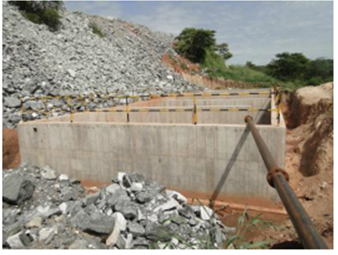
Water should be allowed to drain out only after sedimentation has taken place. Important locations such as tunnel portals and aggregate processing plants and batching plants etcetera are some of the locations where sedimentation tanks are to be provided.
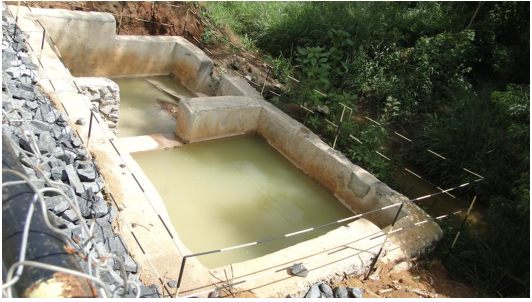
It is necessary to manage construction activities as per specifications, and strict monitoring and controls are to be provide.
Take all necessary steps for pollution control of air water and land areas associated with construction project.
Follow up of environment control / management Act.
Biodiversity maintenance norms and construction project specifications, policy and procedures decided along with necessary control measure must be followed in totality.
Mange the storm water drainage, project roads management, by controlling the inflow of pollutants in drains and sprinkling roads with water at desired interval.

Follow the machine and equipment use procedures.
Implement the system for optimum and required use of the equipment to check pollutants generation.
Necessary test and control measures should be taken by site construction units, supervision units and third-party checks.
Maintain proper documentation, for operating procedures of machine and equipment, used in construction works. Audits and Inspection of the work should be done as per standard requirements.
Administration of contract as per contact document is necessary,
along with other support requirements of contract provisions.
Awareness creation should be given priority. A sincere effort in awareness creation, and its follow up to requirement, makes a big difference.
On site instructions during pre-construction stage, during construction stage and post construction stage should be displayed for every activity related to pollution control.
Quality control team should provide necessary feedback and issue Notices for Nonconformance. There should be regular testing, monitoring, reporting, and discussions, on control measures.
The most important steps taken are at the higher levels are:
The clearly and coordinate based site map of construction project ,that fulfill the requirements, should be handed over to the construction agency (CA).
The CA must keep the project area fenced with gates, for safety and security. The activities areas inside the occupied areas should be marked and the maps should be revised periodically based on the pace of development inside the area.
All the stakeholders should participate in providing support to mandatory control measure
Construction of check dams on natural drains and streams, help in creating low velocity of water, which provides more settling time to particles and checks flow of sediments.
Check dams provide more time to store water and, the water percolates to recharge the ground water.
Check dams can increase the ground water table in river basins.
City sewage must be treated in sewage treatment plants and only treated effluents be allowed to join the river.
Coliform exists in the bodies of warm-blooded animals and humans. And are passed out as fecal matter in environment. Their availability in water test samples results, indicate that the water was in contact with fecal waste and as such may contain disease causing organisms.
Pollutant Control
Real time data collection and monitoring system are in place in this age of advanced computer and data transmission technology. Weather Station data is also available. All such data can be analyzed foe meaningful information which can be used for pollution control of effluents.
Major control parameters are
BOD– Biochemical Oxygen Demand (BOD, also called Biological Oxygen Demand) is the amount of dissolved oxygen needed (i.e. demanded) by aerobic biological organisms to break down organic material present in a given water sample at certain temperature over a specific time. The BOD value is most commonly expressed in milligrams of oxygen consumed per liter of sample during 5 days of incubation at 20 °C and is often used as a surrogate of the degree of organic pollution of water.
COD-In environmental chemistry, the chemical oxygen demand (COD) is an indicative measure of the amount of oxygen that can be consumed by reactions in a measured solution. It is commonly expressed in mass of oxygen consumed over volume of solution which in SI units is milligrams per liter (mg/L). A COD test can be used to easily quantify the number of organics in water. The most common application of COD is in quantifying the amount of oxidizable pollutants found in surface water (e.g. lakes and rivers) or wastewater. COD is useful in terms of water quality by providing a metric to determine the effect an effluent will have on the receiving body, much like biochemical oxygen demand (BOD). —-Source Wikipedia
Coliforms–Coliform bacteria are organisms that are present in the environment and in the feces of all warm-blooded animals and humans. Coliform bacteria will not likely cause illness. However, their presence in drinking water indicates that disease-causing organisms (pathogens) could be in the water system.
pH Value –pH is the measure of acidity or alkalinity of an aqueous solution. The term pH refers to the potential hydrogen/hydroxyl ion content of a solution. Solutions ionize into positive and negative ions. If a solution has more hydrogen (positive) ions than hydroxyl (negative) ions, then it is acidic and has a pH in the range of 0 to 6.9. Alternatively, if a solution has more hydroxyl (negative) ions than hydrogen (positive) ions then it is alkaline with a pH in the range of 7.1 to 14. Pure water and deionized water have a balance of hydrogen (H+) and hydroxyl (OH-) ions and is therefore pH neutral (pH 7).
If the pH of a solution is not within the correct range the plant will not have the ability to absorb some of the essential elements required for proper plant growth. All plants have a pH range, which will produce healthy growth, and this level will vary from plant to plant, but most plants prefer a slightly acidic growing environment (5.8 to 6.2), although most plants can survive in an environment with pH values between 5.0 and 7.0.
Plants grown in acidic environments can experience a variety of symptoms, including aluminum (Al), hydrogen (H), and/or manganese (Mn) toxicity, as well as nutrient deficiencies of calcium (Ca) and magnesium (Mg).
Conversely, in alkaline environments molybdenum (Mo) and macronutrients (except for phosphorus) availability increases, but phosphorus (P), iron (Fe), manganese (Mn), zinc (Zn), copper (Cu) and cobalt (Co) levels are reduced, and may adversely affect plant growth.
Best Availability of Salts | pH Value Range |
Nitrogen | 6-8 |
Phosphorus | 7-10 |
Potassium, Sulphur | 6-10 |
Calcium | 7-8 |
Magnesium | 6-8 |
Iron | 4-6 |
Magnesium, Copper, Zinc | 5-7 |
Molybdenum | 6-10 |
From the chart above each element can become more and less available to the plants as pH changes. If the pH of your solution is out of the desired range, one or more of the essential elements will become unavailable to the plant, causing nutrient deficiencies, which will result in slow growth rates, and poor yields.
Actions Required
The effluents from the surface treatment plants, construction sites, industries need to be treated with best available technology and tested with digital instruments.
The technological upgradation must be taken on priority.
All actions must be based on quality plans and assurance measures, predetermined to the satisfaction of standard requirement. The Quality Control feedback, and the modifications on the feedback, if required must be done immediately.
Standard laboratories with latest equipment and technology must help in testing the quality of effluents.
The receiving bodies quantity capacity and quality capacities must be ascertained before allowing disposal into them.
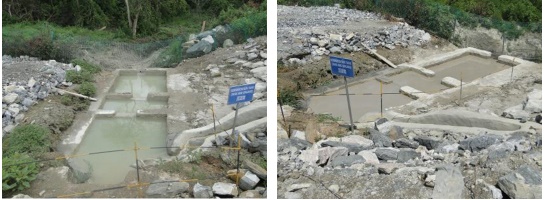
‘The simplified technology use’ properly standardize must be enforced by awareness creation and mandatory laws.
The discharges from tannery, textile, paper, plastics, petrochemical and food processing mills, and other pollutants creating units must be checked for COD and BOD, before and after effluent treatment.
Dust creating plants must have:
Dust catchers and removers. Such collected dust laden water must be disposed through settling tanks.
Greenery in the area must be developed.
Provide water sprinkling system in the plants
Provide metaled roads in the area
Wind breakers should be provided.
Equipment and vehicles used must follow latest technology norms
Temperature of the effluents must not be higher by 5 degree centigrade with respect to receiving body temperature.
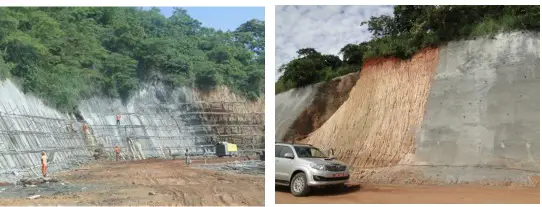
The construction project road stabilization and sediment control measures.
Request -Blog posts from Tec Consults shall be based on the topics given in the ‘JOIN US’ page, but not limited to available list of topics on the http://www.techconsults.in. Viewers are now free to join TecConsults and can contact sksaxena@techconsults.in and info@techconsults.in for their suggestions.
SNo. | Subject | BLOG NAME | POST DATE | |
1 | EI | Work place Environment EI -1 | SK_1 | AUGUST 3,2018 |
2 | EI | Emotional Intelligence at Workplace ½ EI-2 | SK-2 | August 12,2018 |
3 | EI | Emotional Intelligence at Workplace 2/2 EI-3 | SK-3 | August 17, 2018 |
4 | PM | Process Development Support- Fitness &EI PM-! | SK-4 | August 30, 2018 |
5 | PM | Project management framework Essential-1 PM-2 | SK-5 | September 3, 2018 |
6 | PM | Project management framework Essential-2 PM-3 | SK-6 | September 12, 2018 |
7 | PM | Professional and Social responsibility PM 4 | SK-7 | September 18 2018 |
8 | PM | Management skills to manage unlawful actions PM 5 | SK-8 | September 19, 2018 |
9 | Q | Water Quality for Consumption & Construction Part 1 Q 1 | SK-9 | October 4, 2018 |
